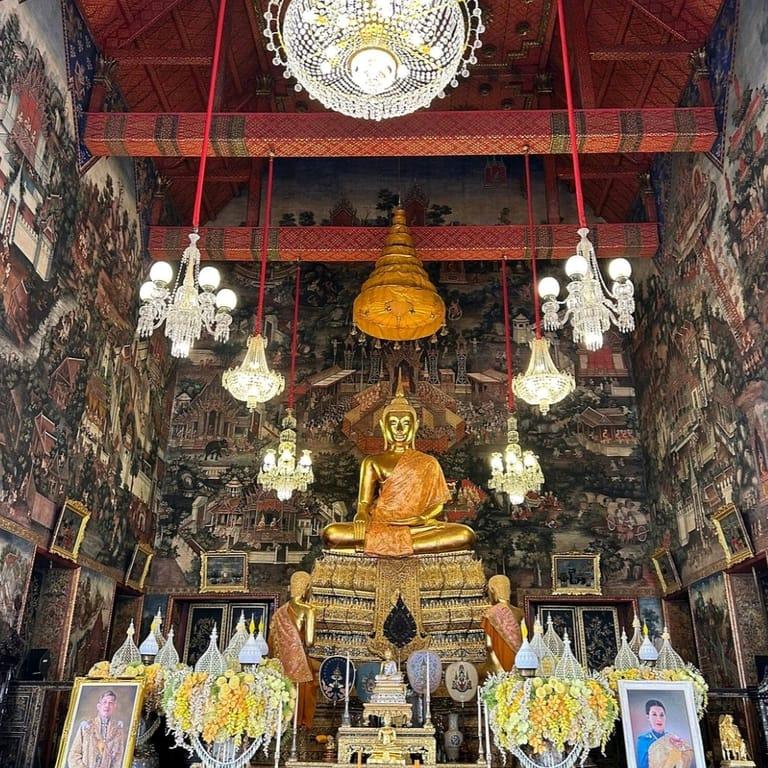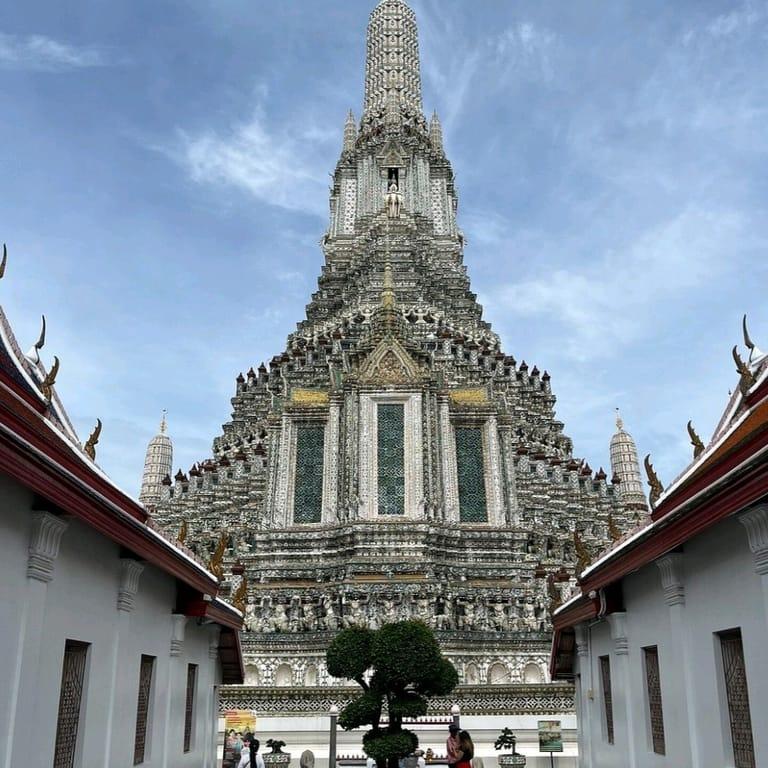Nestled along the scenic Chao Phraya River, Wat Arun Ratchawararam Ratchawaramahawihan, popularly known as the Temple of Dawn, is a breathtaking jewel of Bangkok's cultural landscape. This monumental Buddhist temple captivates visitors with its iconic ornately tiled central prang (spire) towering skyward, reflecting exquisite craftsmanship and spiritual significance.
Visitors are enchanted by the temple’s intricate porcelain shard decorations and steep staircases that invite an adventurous climb. From the top, panoramic views of the city and river unfold, offering a unique perspective of Bangkok’s vibrant life. Whether you’re a history buff, a photography enthusiast, or a cultural explorer, Wat Arun promises a memorable experience steeped in tradition and stunning visual beauty.
Wat Arun stands out not only for its architectural grandeur but also for the lively atmosphere created by visitors immersing themselves in Thai culture. Many tourists delight in renting traditional Thai costumes to capture vibrant photos against the temple’s ornate backdrop. The riverside setting enhances the temple’s serene aura, especially during the magical hours of sunset.
- Iconic architecture featuring intricate porcelain details and towering spires.
- Stunning riverside location that enhances peaceful ambiance and photo opportunities.
- Traditional Thai costume rentals for unique cultural photo experiences.
- Steep climb to central prang offering panoramic views of Bangkok and the river.
To fully enjoy your visit to Wat Arun, plan to arrive early in the morning or during late afternoon hours. These times allow you to avoid the busiest crowds and experience the temple in cooler, more comfortable weather. The temple grounds are spacious but can feel crowded during peak hours, especially when tourists dress in elaborate Thai costumes for photos.
Entrance for foreign visitors is 200 Thai Baht, and a small ferry ride costing 5 baht each way from across the river makes the temple feel like a special riverside adventure. Remember to wear modest clothing covering your shoulders and knees; sarongs are available for rent at the entrance for added convenience. Also, be cautious as some stairways are steep and lack railings — suitable for visitors with good mobility.
- What is the best time to visit Wat Arun? Early morning or late afternoon is recommended to avoid crowds and enjoy cooler temperatures.
- Is there an entrance fee for Wat Arun? Yes, the entrance fee for foreign visitors is 200 Thai Baht.
- What should I wear when visiting Wat Arun? Visitors should dress modestly, covering shoulders and knees. Sarongs are available for rent at the entrance if needed.
- Can I climb the central prang? Yes, visitors can climb the steep stairs of the central prang for panoramic views of Bangkok.
- Are there any nearby attractions to visit? Yes, nearby attractions include Wat Pho, the Grand Palace, and Chao Phraya River cruises.
Positive
Visitors consistently praise Wat Arun for its stunning architecture and rich history. The serene riverside atmosphere and photogenic features make it a favorite for cultural enthusiasts and photographers alike. Many recommend arriving early to savor the tranquility before the crowds arrive and embrace the fun of traditional Thai costume rentals for unique photo memories. The temple’s illumination at night adds a magical touch that leaves lasting impressions.
Nestled on the banks of the Chao Phraya River in Bangkok, Thailand, Wat Arun, also famously known as the Temple of Dawn, stands as a monumental symbol of Thai history and architectural grandeur. This iconic Buddhist temple is renowned for its ornately tiled central prang (spire), richly adorned with colorful porcelain, which vividly reflects Thailand’s rich cultural heritage.
Wat Arun’s origins date back to the Ayutthaya Kingdom period, but it was after the fall of Ayutthaya in 1768 that King Taksin restored this sacred site, marking a pivotal moment in its history. This restoration symbolized not only religious devotion but also renewal during a turbulent era.
- 1768: King Taksin restored the temple after the fall of Ayutthaya.
- 1809: King Rama II initiated plans to raise the main pagoda to 70 meters, signaling a grand architectural vision.
- 1851: Completion of the main prang after nine years of meticulous construction, cementing its place as an architectural masterpiece.
- 2013: Extensive restoration commenced to replace damaged tiles and reinforce the structure using traditional lime plaster techniques.
- 2017: Restoration work concluded successfully, aiming to restore the temple’s original majestic appearance revered by locals and visitors alike.
Wat Arun’s central prang is a stunning example of Thai craftsmanship, decorated with intricate porcelain shards that shimmer in the sunlight. This spectacular spire not only represents religious devotion but also Thailand’s architectural heritage, attracting millions of visitors annually. The temple’s riverside location adds to its charm, offering breathtaking views of the Chao Phraya River, especially during sunrise and sunset.
The climb up the temple’s steep steps rewards visitors with panoramic vistas and a tangible connection to Bangkok’s past. Photography enthusiasts often capture the temple’s photogenic beauty, especially in the golden hours around 5 to 6:30 pm. Many tourists embrace local culture by adorning traditional Thai costumes, adding a vibrant and immersive experience to their visit.
- Arrive early in the morning to avoid crowds and the midday heat.
- Take the affordable 5 baht ferry across the river for a scenic approach.
- Be cautious climbing the steep steps, especially for elderly and children.
- Entry fee is 200 baht, which supports the temple’s preservation efforts.
Nestled along the banks of the Chao Phraya River in Bangkok, Wat Arun Ratchawararam Ratchawaramahawihan, also known as the Temple of Dawn, stands as an architectural marvel and a beacon of spiritual heritage. This temple is renowned for its stunning and unique design, featuring a central prang — a towering spire adorned with intricate porcelain tiles that catch the sunlight beautifully. Visitors are drawn to its rich historical significance and the profound cultural experience it offers, making it a must-visit sight for travelers exploring Thailand’s vibrant capital.
Architectural beauty and panoramic views are among the temple’s most celebrated features. The climb up the central prang offers breathtaking vistas over the river and surrounding Bangkok skyline, rewarding those willing to navigate the steep and narrow stairs. The temple’s illumination at night creates a magical atmosphere that captivates photographers and romantics alike.
- Stunning and unique architecture: The temple’s ornate porcelain tile work and towering spires stand apart from other Bangkok temples.
- Rich historical significance: Wat Arun represents centuries of Thai culture and religious tradition, offering a spiritual journey for those interested in Buddhist heritage.
- Panoramic views from the central prang: Visitors who ascend the temple’s steep steps are rewarded with sweeping views of the Chao Phraya River and Bangkok’s cityscape.
- Cultural and spiritual experience: The temple provides an authentic glimpse into local religious practices and Thai cultural traditions, enhanced by the ambiance of the riverside setting.
- Illumination at night: At night, the temple’s lighting transforms the structure into a breathtaking spectacle, ideal for evening visits and photography.
While Wat Arun offers a spectacular experience, visitors should be mindful of several practical considerations to ensure a comfortable and respectful visit.
- Steep and narrow stairs: The ascent to the central prang involves climbing steep, narrow staircases without railings, which can be challenging for elderly visitors or those with mobility issues.
- Crowds during peak hours: The temple is a popular tourist destination, often busy especially mid-morning to afternoon, which can affect the sense of tranquility and photo opportunities.
- Dress code enforcement: Visitors must adhere to respectful attire rules. Stricter enforcement means inappropriate clothing may result in denied entry, so plan accordingly.
Despite these challenges, early morning visits and preparation can greatly enhance your experience, allowing you to witness the temple’s serenity and beauty in optimal conditions. Whether for cultural appreciation, spiritual reflection, or photography, Wat Arun remains one of Bangkok’s most iconic and rewarding destinations.





